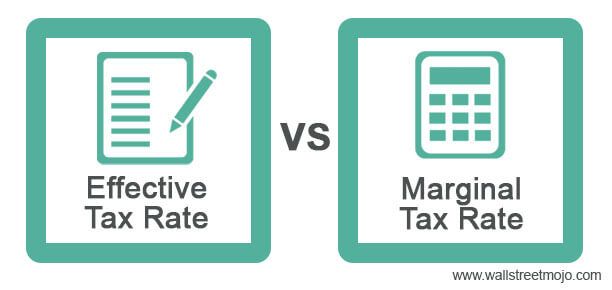Table Of Contents
Difference Between Effective and Marginal Tax Rate
The effective tax rate is the percentage chargeable on the total taxable income of individuals or organizations. While the marginal tax rate is a progressive tax rate chargeable on any additional income above the taxable income limit.

The marginal tax rate increases proportionately to taxable income, in contrast to the effective tax rate, which is fixed for all taxpayers. The effective tax rate is a flat tax, and under this system, everyone pays tax, regardless of their income level.
Effective vs Marginal Tax Rate Infographics
Let’s see the top differences between the effective vs. marginal tax rates.

Differences Between Effective and Marginal Tax Rate
- The effective tax rate method does not protect the taxpayer; when income goes down, the tax rate does not go down. Whereas, the marginal tax rate protects the persons who pay taxes; when taxable income decreases, the tax rate also decreases.
- The effective tax rate method encourages business expansion as higher-income would attract effective taxes. In comparison, the marginal tax rate method discourages business expansion as higher-income would attract higher taxes.
- The government earns less revenue under the effective tax rate method. In comparison, in the marginal tax rate the government earns more revenue.
- The tax burden is shifted to the general income group under an effective tax rate method. Whereas under marginal tax rate responsibility to pay tax is moved to the persons who have a higher income.
- There are no significant compliance checks for paying the tax under the effective tax rate method due to a single tax rate. Whereas under the marginal tax rate method, there are significant compliance checks for paying the tax due to multiple tax rates.
Comparative Table
| Basis | Effective Tax Rate | Marginal Tax Rate |
|---|---|---|
| 1. Meaning | It is the percentage of taxable income that effectively pays in taxes. | It is the percentage of tax that will pay an additional amount of taxable income. |
| 2. Calculation | This tax amount is calculated based on the tax rate multiplied with taxable income. | Under this tax method, the amount is calculated on the basis of different types of tax rates. |
| 3. Earning | The government earns less revenue under this tax method. | The government earns more revenue under this tax method. |
| 4. Tax Burden | The tax burden is shifted to the general income group. | Responsibility to pay tax is moved to the persons who have a higher income. |
| 5. Protection | It does not protect the taxpayer when income goes down, tax will go down. | Protects the persons who pay taxes, when taxable income decreases tax will also be decreased. |
| 6. Business Expansion | It encourages business expansion as higher-income would attract effective taxes. | It discourages business expansion as higher-income would attract higher taxes. |
| 7. Compliance Checks | There are no significant compliance checks for paying the tax under this method due to a single tax rate. | There are major compliance checks for paying the tax under this method due to Multiple tax rates. |
